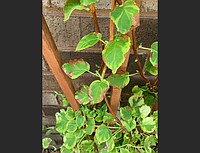Q: We planted two variegated climbing hydrangeas last summer on trellises at our house in Bentonville. I nursed them through the extreme cold in February by covering them with pieces of tarp and hanging a light bulb off each trellis. They came back this spring but have these brown edges on the leaves and vines, even on this year's new growth. They face about 30 degrees east of north and receive some morning sun but not much direct sunlight after that. Considering what we paid for these, we'd really like them to thrive. The yew bushes and vincas and impatiens beside them seem to be doing fine. Any suggestions?
A: The pattern on the foliage looks more like a burn than a disease, but to be sure, I would recommend taking both a soil sample (a pint of soil) and some leaves to your county extension office. Have you been fertilizing much this growing season? Have the brown edges been happening all season or just recently? It doesn't look life-threatening at this point, but I would investigate to see if you can find a cause and then correct it.
■ ■ ■
Q: I am having trouble with yellowing and dying of the leaves on my geraniums. I still have plenty of buds and blooms. Do you think it is too much, too little or inconsistent watering? Or something else?
A: Geraniums can struggle in extremely hot and humid weather, and we sure had that recently. Keep them watered, but well-drained. Fertilize lightly, and they should perk up with cooler weather.
Photo Gallery
In the Garden — August 7, 2021
Photographs intended to accompany Janet Carson's "In the Garden" column published August 7, 2021.
[Photos not displaying? See arkansasonline.com/87carson]
Q: My purple-hull peas are not blooming, and I am wondering why?
A: I assume the plants get at least six or eight hours of sunlight a day. The usual cause of low pod set or flowering on southern peas is over-fertilization, particularly with nitrogen. Peas are able to fix nitrogen from the atmosphere, so they don't need as much fertilizer as other vegetable crops.
■ ■ ■
Q: Can you tell me the name of this beauty? I know it's some kind of begonia. I've had it outside and not in the sun at all. It doesn't seem to like the outdoors, so I brought it in. It gets lots of indirect light. Also, how would I care for this, other than not getting the leaves wet?
A: The begonia family is one of the largest flowering-plant families with about 1,500 species and hundreds of hybrids. From your picture I would guess it is one of the cane-like varieties because of the strong stems or canes that are visible in your picture. One of the oldest cane begonias is Angel Wing. They would do well outdoors in the shade for the summer months with no direct sunlight, especially afternoon sun. They like ample moisture but not wet feet. They propagate easily by leaf or stem cuttings. If the plant gets too leggy, it can be cut back to prompt it to fill out. Indoors they will do fine with brighter light.
■ ■ ■
Q: I have established blueberry plants, a mix of Sunshine and Duke, 3 to 5 feet tall, which have produced well for a number of years. I'm losing my gardening spot and will try to move some. Because of their size, would it be possible to prune them, raise them and split the roots in half with a cutting tool?
A: Blueberry plants are cane-producing plants, meaning there is not just one trunk but a series of canes. When you transplant them, you could divide them. Now is not the time to do this. Wait until they are dormant when it will be less traumatic for them. Pay attention to soil moisture this winter and water when dry — particularly before a cold snap — to help the roots re-establish.
Retired after 38 years with the University of Arkansas Cooperative Extension Service, Janet Carson ranks among Arkansas' best known horticulture experts. Her blog is at arkansasonline.com/planitjanet. Write to her at P.O. Box 2221, Little Rock, AR 72203 or email jcarson@arkansasonline.com

